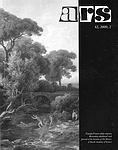
Časopis ARS 42 (2009) 2
Dana BOŘUTOVÁ
Jurkovičova Viedeň[Architect Jurkovič and Vienna]
(Resumé)
The present study yields new facts and details on the life and work of architect Dušan Jurkovič, and - exploiting recent research of archive documents - submits novel findings on crystallization of his artistic profile. Its dominant point of interest is to elucidate Jurkovič's relations to Vienna that - due to the education gained at the Staatsgewerbeschule as well as due to diverse later contacts and impulses - had left distinct traces in architect's life and work. Vienna, at the turn of the 19th to the 20th century an important European centre of arts, emanated impulses epitomized by the Wagner's school of architecture and the Wiener Werkstätte, to which Jurkovič vividly responded. At the same time, Vienna performed a gate, through which the impulses coming from foreign centres were entering Central Europe. Among these, the most relevant for Jurkovič were influences coming from Britain - the Arts & Crafts movement - and their variants elaborated in the German artistic milieu.
Adequately to this context - and along with the relevant questions of the current research* - the study is conceived as a suite of freely united features grasping individual aspects of Jurkovič's relationship to Vienna and elucidating his way of treating the given impulses (as documented in extensive quotations from his personal correspondence).
The first feature (entitled Years of the Study) is focused on the years of study at the Viennese Staatsgewerbeschule - based on the recent findings of the archive documents it brings novel details on the young artist's personal life and the beginnings of his professional practice. Jurkovič's correspondence provides information on his everyday life in Vienna, marked with permanent lack of money, brings insight in some of the tasks he had to cope with to advance his study. And it also points to some completely novel facts related to Jurkovič's study period - i.e. his practice in the firm C. Korte & Comp., Bau-Unternehmung für Wasser- und Gas- Anlagen in Bratislava (then Pressburg).
The second feature (entitled The Viennese Lesson) observes the process of Jurkovič's adoption and indigenous transformation of the lessons taken from the Viennese school that resulted in formation of his notion of architecture as documented by his early works culminating in the ensemble of tourist facilities at Pustevne (i.e. designs published in Der Architekt in 1900, 1901 and 1905). The orientation to vernacular sources, exemplified on Alpine wooden architecture by his professors, Camillo Sitte and Rudolf Feldscharek, became confronted with the Slovak version of the concept as presented by Blažej Bulla in Martin, and subsequently being adopted and transformed by Jurkovič, it performed the fundament to his own concept of architecture.
The third feature (entitled The Revived Contacts - Vienna as the Gate to Europe) concentrates to the architect's revived contacts with the Viennese milieu at the turn of the centuries and follows the process of crystallization of Jurkovič's specific style to which contemporary artistic Vienna represented an important catalyser. The analysis of the specimens of Jurkovič's interior design dating from the years after 1900 (e.g. designs made for František Mareš, 1902; the show rooms for the Club of Friends of Art in Brno, 1904; or the bank manager's office in Ružomberok, 1907) indicates the architect's great concern for activities of his contemporaries from the Wagnerschule, and above all of Josef Hoffmann, one of the co-founders of the Wiener Werkstätte. Lessons taken from them are believed to have been supporting impulse for Jurkovič to continue his way of penetrating the substance of form - the way he entered more than ten years earlier. Consequent abstraction of form led him to geometrization, indispensably accompanied with diminution of the former exuberance of forms. However, this "ascetic" concentration in fact resembles the process, he already absolved when struggling through the external richness of folk architecture deeper into the structural and functional essence of architectural form. Thus, at this new stage of developing his own concept, geometry, the "primeval teacher of artists", became the device for appreciation and confirmation of Jurkovič's own standpoints - the device bringing discipline and concentration along with purification and refinement, anchoring the artistic intuition and supporting the forcibility of expression. Jurkovič's response to his Viennese contemporaries resulted in a novel style, strengthening his artistic self-confidence and opening the possibility to settle diverse future incentives with both flexibility and inner coherence.
* The study is based on results of research executed in the frames of the VEGA project No. 1/0316/08 Europe and us - us and Europe: Inclusions of the European in the 19th century art in Slovakia, financed by the Scientific Grant Agency of the Ministry of Education of the Slovak Republic and the Slovak Academy of Sciences.